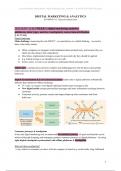uva msc business administration: digital marketing track | semester I - period II (2023-2024) [by gycc]
DIGITAL MARKETING & ANALYTICS
[6314M0311Y] - lecture & tutorial notes
2023.10.30 - 11.02 | WEEK 1: digital marketing analytics:
platforms, data types, metrics, touchpoints, conversion-attribution
[LECTURE]
Digital landscape
Main challenge: measuring the real IMPACT – no speculation, no wishful thinking – we need to
know what really matters
● Often, companies or managers would implement data-oriented tools, just because they see
others are also doing it (the competitors)
● Most times, implemented strategies cannot be answered why they should be applied
● E.g. Tiktok is huge so we should be on it as well!
● In this course, we aim to use numbers to understand which strategies work
Online data is getting more and more complex and challenging now; but the data is also getting
richer and more diverse to have a better understanding and then, predict and manage customers’
behaviour.
Digital Personalisation & User Generated Content make today’s digital platforms substantially
different than traditional offline marketing:
● TV, radio, newspaper: non-digital traditional media (same message to all);
● New digital media (unique-personalised messages and more information exchange between
customers
● Customers actively generate content and impact/shape-up other customers and firms’
behaviour
Customer journeys & touchpoints
In the end, digital marketing tries to understand the customer journey: all goals and benefits can be
achieved through designing and managing seamless customer journeys on digital platforms – by using
right digital touchpoints synchronised with offline platforms & touchpoints.
What are these touchpoints?
⇒ any contact or encounter you have with the company or brand (e.g. social media, blog, billboard)
1
, uva msc business administration: digital marketing track | semester I - period II (2023-2024) [by gycc]
Paid-owned-earned media/touchpoints:
most widely used classification in marketing &
ads practise.
● Paid media ⇒ where you pay for
media, e.g. ads, search engine ads +
promoted social media content
○ A vlogger or influencer
promoting a brand is by
definition paid media
● Owned media ⇒ all channels owned by a company; where you can post your info for ‘free’
● Earned media ⇒ most difficult, yet most valuable; WOM, conversations, comments,
reviews, shares, etc.
○ However, going one step beyond, the customer-to-customer sharing stimulated by
influencer (without getting paid), this is categorised as an earned activity
Extension on the framework ⇒ category media →
relates to the category that doesn’t mention the ad’s
brand nor the focal brand. Instead, it captures (1)
competitors' media channels and (2) independent
publications related to the product category.
Motivation: control level on earned (individuals) and
category (publications, competitors) is different.
Control: earned > category
2
, uva msc business administration: digital marketing track | semester I - period II (2023-2024) [by gycc]
Digital data types & metrics
Classification 1 – structure
Data needs preprocessing before it can be applied and interpreted. Data can be structured vs
unstructured in nature. The management and analysis of the data depends on the structure.
● Structured data → mostly quantitative (numeric)
○ E.g. sales in euro, click/no click (0-1), session time, number of likes
● Unstructured data → mostly qualitative: textual or visual data: pictures / videos
○ E.g. instagram videos, online reviews, social media posts
The importance of unstructured data is rapidly increasing. Recent projections indicate that
unstructured data is over 80% of all business-marketing data.
Example.
Classification 2 – source of the data
● On-site data → what you see on website: available and visible to anyone (extracted through
data/web scraping)
○ Web scraping ⇒ extracting data from websites
○ E.g. through website’s product lists, comments, reviews – visible to all (either
structured – e.g. nr. of likes, OR unstructured – e.g. user reviews in text)
○ Through scraper-software and importing to local database
3
, uva msc business administration: digital marketing track | semester I - period II (2023-2024) [by gycc]
● clickstream/session data → traffic on website-app: what, when and how people do online
(this is not visible to visitors – e.g. users won’t know how long someone was scrolling on IG)
(e.g. sources – Google analytics, Double Click, etc.)
Digital data with emotions and behaviour
⇒ can also include (1) business outcomes and (2) customer attitudes/emotions
Emotions and attitudes are non-observable. However, this link can be built by:
1. Integrating survey (online marketing research) data with click-web data and business
outcomes
2. Interpreting/drawing conclusions on possible emotional outcomes as a result of online
behaviour. E.g. analysing emojis on social media
First, second, third (and zero) party data
From a broader perspective. Third party data does not have to be sold/commercialised but it also
includes other party public data-sets.
● First-party data → firm obtains data directly from/with own sources, company owns it
○ Valuable > information firsthand from your
customers
○ Most effective and reliable form of data
collection
○ Examples:
■ Google analytics
■ Customer surveys, feedback, interviews,
etc.
■ Website analytics
4




